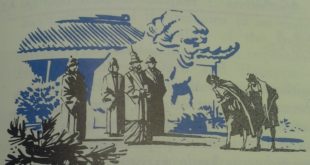In the same way that important ancient civilizations grew out of small beginnings in the valleys of the Nile, the Tigris-Euphrates and the Indus, so another great civilization of Early times — that of China — was cradled in the valley of the Yellow River. To be sure, China’s civilization did not commence as early as did Egypt’s, Mesopotamia’s, or India’s. The ancient Egyptian and the Mesopotamian kingdoms lost their power many centuries ago and early India never became completely united under one empire. China therefore has had a longer national life than any other ancient or modern state. It …
Read More »Two and a Half Centuries of Unrest in Japan A.D. 1336-1573
Go-Daigo had found refuge in a place in the mountains called Yoshino. Japan now had two emperors, one in Kyoto and the other in Yoshino. Takauji set out to simplify matters. As a first step, he had his puppet, the Kyoto emperor, appoint him shogun. In this way, Takauji became the founder of a new line of shoguns who were called, after their family name, the Ashikaga shoguns. Their shogunate lasted from 1336 to 1573, nearly twice as long as the Kamakura shogunate. Takauji and his successors did not rule anywhere near as firmly as Yorimoto and the Hojo family. …
Read More »The Sung Dynasty: Barbarians Threaten the Empire A. D. 960 – 1279
DURING THE turbulent Five Dynasties and Ten Kingdoms era, the main outside threat to China came, as usual, from the north. A tough Mongol people from Manchuria helped one of the Chinese Warlords conquer North China. In return, he let them settle around Peking. Some of them became farmers, but their nomadic habits of roving and fighting remained strong. From time to time they raided the North China Plain, striking terror into the hearts of the peasants. These troublesome people were called the Khitan. Another form of their name, Khitai, sounded like “Cathay” to European travelers who later came to …
Read More »The Six Dynasties: Turmoil and Change A.D. 220-589
THE three states into which China had split were soon split up themselves into even smaller divisions. For three and a half centuries, war raged almost continuously among rival kings. Doubt and confusion were everywhere. The period between 220 and 589 is called the Six Dynasties era, after six ruling families in a row which used Nanking as their capital. In all those years‚ the memory of the Han Empire never died. Looking back longingly at the peace and order of that time, the people came to think of the Han government as the great model which all rulers should …
Read More »The Land of the Great Wall 4000 B.C. to A.D. 220
For many generations, the ancestors of P’an Keng had considered themselves kings in northern China. Yet this family of kings, the Shang Dynasty, had never governed from a central capital. About 1380 B. C., P’an Keng decided it was time to set up a capital. He found what seemed to be the perfect site at Anyang. Situated near a bend in China’s Yellow River, the fertile plains were ideal for farming and pasture, while the mountains behind it had timber and wild game. Only one thing remained: P’an Keng had to find out if the move was approved by the …
Read More »



